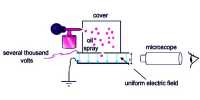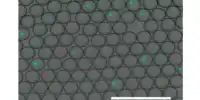Scientists discovered a single-molecule circuit for exploiting destructive quantum interference
Scientists have discovered strongly nonlinear transport between single-molecule junctions by disruptive quantum interference. Researchers, led by Columbia Engineering Professor Latha Venkataraman, announce today that they have discovered a new theory of chemical design for the exploitation of disruptive quantum interference. They used their method to construct a six-nanometer single-molecule transition where the on-state current is more than 10,000 times greater than the off-state current-the greatest shift in current accomplished by a single-molecule circuit to date.
This new switch depends on a form of quantum interference that has not been studied so far. Researchers used long molecules with a special central unit to intensify disruptive quantum interaction between various layers of electrical energy. They have also shown that their technique can be used to generate very stable and reproducible single-molecule switches at room temperature that can hold currents exceeding 0.1 microamps on-site. The length of the switch is comparable to the size of the smallest computer chips currently on the market and its properties are similar to those of commercial switches. The research has been published today in Nature Nanotechnology.
The Colombian team discovered a single-molecule circuit with a length of 6 nanometers that has a very large on/off ratio due to quantum interference; this discovery enables faster, smaller, and more energy-efficient devices.
“We observed transport across a six-nanometer molecular wire, which is remarkable since transport across such long length scales is rarely observed,” said Venkataraman, Lawrence Gussman Professor of Applied Physics, Professor of Chemistry, and Vice Provost for Faculty Affairs. “In fact, this is the longest molecule we have ever measured in our lab.”
Over the past 45 years, gradual reductions in transistor size have contributed to significant increases in data processing and ever-reducing package sizes. Today’s smartphones contain hundreds of millions of silicon transistors. Present methods of producing transistors, however, are quickly reaching the scale and performance limits of silicon. So, if data processing is to be improved, researchers need to build switching processes that can be used for new materials.
Venkataraman is at the vanguard of molecular electronics. Her laboratory tests the fundamental properties of single-molecular devices, trying to understand the interplay between physics, chemistry, and nanometer-scale engineering. She is especially interested in developing a better understanding of the basic mechanics of electron transport thus setting the basis for technological advances.
At the nanometer scale, electrons operate as waves rather than particles, and the transport of electrons takes place by tunneling. Like waves on the surface of the water, electron waves may interact constructively or destructively. This results in non-linear systems. For eg, if two waves interact constructively, the amplitude (or height) of the resultant wave is greater than the sum of the two separate waves. Two waves can be completely undone with disruptive interference.
“The fact that electrons behave as waves are the essence of quantum mechanics,” Venkataraman said. Quantum mechanical effects dominate the transport of electrons at the molecular scale. Researchers have long predicted that the nonlinear effects created by quantum interference could allow single-molecule switches with broad on/off ratios. If they could use the quantum mechanical properties of molecules to make circuit components, they could allow quicker, smaller, and more energy-efficient devices, like switches.
“Making transistors out of single molecules represents the ultimate limit in terms of miniaturization and has the potential to enable exponentially faster processing while decreasing power consumption,” said Venkataraman. “Making single-molecule devices that are stable and able to sustain repeated switching cycles is a non-trivial task. Our results pave the way towards making single-molecule transistors.”
A typical analogy is to think of transistors as a pipe valve. The water flows into the pipe while the valve is open. The water is blocked when it is closed. In transistors, the flow of water is replaced by the flow of electrons or the current. Present flows in the on-state. The present is blocked in the off-state. Ideally, the amount of current flowing in on-and-off-states must be somewhat different; otherwise, the transistor is like a leaky pipe where it is impossible to know if the valve is open or closed. Because transistors act as switches, the first step in the design of molecular transistors is to design systems where the current flow can be transferred between on-and-off-state transistors.
However, most past designs have developed leaky transistors using short molecules where the difference between on-and off-state was not important. Venkataraman and her colleagues faced a variety of challenges to resolve this. Their key challenge was to use the principles of chemical design to construct molecular circuits where quantum interference effects could strongly inhibit off-state current, thus alleviating leakage problems.
“It is difficult to completely turn off current flow in short molecules due to the greater probability of quantum mechanical tunneling across shorter length scales” explained the study’s lead author Julia Greenwald, a Ph.D. student in Venkataraman’s lab. “The reverse is true for long molecules, where it is often difficult to achieve high on-state currents because tunneling probability decays with length. The circuits we designed are unique because of their length and they are large on/off ratio; we are now able to achieve both a high on-state current and very low off-state current.”
The Venkataraman team developed their devices using long molecules synthesized by collaborator Peter Skabara, Ramsay Chair of Chemistry, and his group at the University of Glasgow. Long molecules are readily stuck between metal contacts to create single-molecule circuits. Circuits are very stable and can withstand high applied voltages repeatedly (exceeding 1.5 V). The electronic arrangement of the molecules increases interference effects, allowing for a marked nonlinearity of the current as a function of the applied voltage, which results in a very high ratio of on-site to off-site current.
Researchers continue to collaborate with the University of Glasgow team to see if their design methodology can be extended to other molecules and to build a method where the transition can be activated by an external stimulus.
“Our building a switch out of a single molecule is a very exciting step towards the bottom-up design of materials using molecular building blocks,” he said. “Building electronic devices with single molecules acting as circuit components would be truly transformative.”















